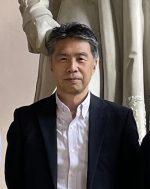Washi Roundtable: Exploring the advantages and creative potentials of Japanese handmade paper

- This event has passed.
November 16th, 2022 @ 6:30 pm - 8:00 pm EST
Details »
For more than a millennium, Japanese papermakers have refined and mastered the process of making washi – a strong, translucent, absorbent, and malleable paper-like material with a multitude of applications ranging from artwork to conservation to interior accessories, and much more. In a co-presentation between JFT and The Japanese Paper Place, we are inviting a panel of washi users and specialists, including an 8th generation papermaker from Shimane Prefecture (Sekishu), to share their unique perspectives on how Japanese paper has endured and thrived throughout the centuries. We will learn about the creative ways artists in Toronto and worldwide are using washi, unique challenges today’s papermakers face, and examine the question of where washi will go from here.
Image credits: Dominique Prevost; Danielle Shatz
SPEAKERS:
Nancy Jacobi founded The Japanese Paper Place 40 years ago on her return to Toronto after living and teaching English in Japan. Her mission then as now, was to encourage creativity with the remarkably versatile papers she had discovered in Japan. After several visits to meet papermakers in their villages, she realized that encouraging the papermakers was equally as important in supporting the papers’ continuing manufacture and use outside Japan.
Through workshops, exhibitions, lectures and attendance at conventions and trade shows, her company has made connections with fellow washi enthusiasts who now distribute Japanese papers worldwide. Nancy’s belief in the importance of Heritage washi (traditional Japanese paper) as one of the world’s great art materials remains undiminished; and the JPP’s ongoing collection of contemporary works by prominent artists using washi is testament to it. In 2021, she was presented by Consul-General Sasayama with the Foreign Minister’s Commendation for her contributions toward the promotion of Japanese culture in Canada.
————————————————————————————–
 Takao Moriki is the third-generation president of Moriki Paper Company, Ltd., based in Tokyo, Japan, and is specialized in the export of various types of Japanese papers, known as “Washi”. The company was established in 1925 as a supplier of Japanese tissue paper called “Tosa Tengujo” and other Japanese papers, especially for overseas markets, by his granduncle, whose family had been papermakers in Kochi prefecture. The company started exporting directly to USA in 1979 and to UK & West Germany in 1983, and has been supplying the largest selection of Japanese papers to over 40 countries until today, having The Japanese Paper Place as a distribution partner since 1980’s.
Takao Moriki is the third-generation president of Moriki Paper Company, Ltd., based in Tokyo, Japan, and is specialized in the export of various types of Japanese papers, known as “Washi”. The company was established in 1925 as a supplier of Japanese tissue paper called “Tosa Tengujo” and other Japanese papers, especially for overseas markets, by his granduncle, whose family had been papermakers in Kochi prefecture. The company started exporting directly to USA in 1979 and to UK & West Germany in 1983, and has been supplying the largest selection of Japanese papers to over 40 countries until today, having The Japanese Paper Place as a distribution partner since 1980’s.
Takao has been working closely with many local papermakers across Japan to support the industry as well as to meet the needs of customers, such as conservators, artists, designers, craftspeople and other creative people around the world.
————————————————————————————–

©MASUDA KOHBOH Inc
After graduating from college in Hiroshima, Masaru Nishita started training to carry on the craft of making Seki-shu Japanese paper in his family’s over 200-year-old business, Nishita Japanese paper workshop.
The technique for making Seki-shu Japanese paper has been handed down from generation to generation for more than 1,000 years. Local tree pulp, mainly mulberry and mitsumata and the hibiscus sap, are diluted in water and their fibers are drained through a screen, so that a mat of randomly interwoven fibers is laid down. Water is removed from this mat of fibers by pressing and drying to make hand-made Seki-shu Japanese paper. This process is called Nagashisuki. Due to the use of sap, Nagashisuki makes a distinguishably thinner paper which is synonymous with the Shimane area. One famous type of Seki-shu is “Seki-shu writing paper”, which in 1969 was designated as an important intangible cultural heritage of the country. Then in 2009 it was registered in UNESCO as an intangible cultural heritage. Due to the high quality of Nishida Japanese paper workshop’s seki-shu, their paper is used to repair various Japanese cultural artifacts.
—————————————————————————————
Co-presented With The Japanese Paper Place
Learn more about Washi (Traditional Japanese Paper) with JFT Library’s books
 Planning to attend Washi Roundtable on November 16? Enhance your learning experience by checking out JFT Library’s book list on washi before or after participating in the event!
Planning to attend Washi Roundtable on November 16? Enhance your learning experience by checking out JFT Library’s book list on washi before or after participating in the event!
Apply for a new library card or renew your expired card here.


